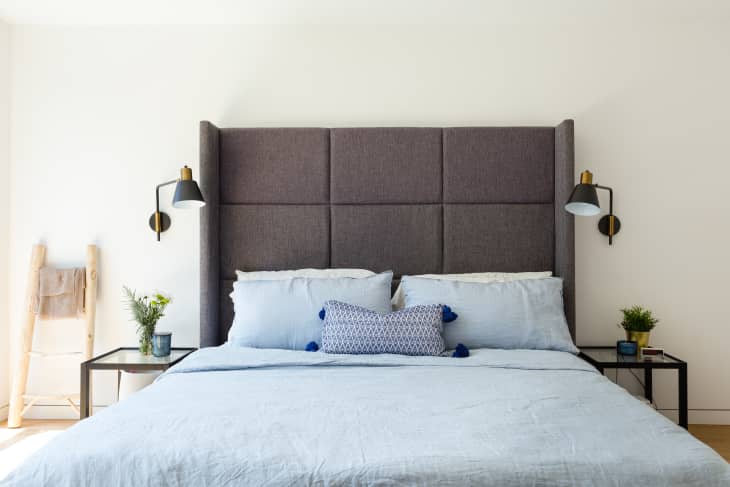The Gross Reason Why You Really Shouldn’t Sleep with Wet Hair
Social media has “made” me do, buy, andtry many things. But thanks to this PSA onwhy it’s bad to sleep with wet hairthat I saw while scrolling, I recently filed a new item under “Instagram made me NOT do this.”
I’ll admit I’ve been guilty as charged. I’ve French braided my hair after a shower and let it air dry into beachy waves later — and yes, there are times that I’ve turned “later” into overnight. But@madamesweatof the House of Hygiene blog and founder ofkaia naturalshad me at “fungus.”
Even though I knowmold— which is indeed a fungus — grows in the presence of excess moisture, I sought a second opinion about whether sleeping with a wet head is truly bad. Keep reading to find out why I will always dry my hair before bedtime now.
Why Your Pillow Can Be aNightmare
Danielle Kelvis, M.D., chief medical advisor atSleepline, confirms that sleeping with a wet head is “not recommended” if you care about your hygiene.
“One of the primary concerns is that the damp environment created by wet hair and the heat from your head can serve as a breeding ground for microorganisms, potentially leading to bacterial and fungal growth on pillows,” she explains. “This increases the risk of developing fungal infections of the scalp, such as those caused by Malassezia [a species of skin fungus].”
Yikes. But wait, there’s more! “Sleeping with wet hair can also contribute to the development of acne and pustules due to the damp environment, which can become itchy or painful,” says Kelvis.
Fungal growthandacne? It’s a no for me. But for those of you who like to use soft foam rollers to do your ‘do overnight, there might besomehope for you.
How to Protect Yourself if You Still Sleep with a Wet Head
I wrote this article, so obviously I have lived to tell about my experience of sleeping with wet hair. But for the sake of your skin and scalp, you should to upgrade your laundry routine if you choose to throw caution to the wind in your ongoing quest for tousled curls.
The Sleep Foundationrecommends washing your sheets and pillowcases at least once a week, more if you share your bed with furbabies. It is also suggested that if you’re going to sleep with wet hair, use asilk pillowcaseor wear a sleep cap/scarf, which can help reduce the friction that leads to hair breakage. But don’t just toss that silk pillowcase in the washer on any setting.
“Delicate fabrics like silk, including pillowcases, shouldn’t be washed too often,” says Brian Jones, VP of marketing atASKO America. “Look for a specified silk setting [on your washing machine] to simply loosen up and refresh the garments as needed.”
How to Clean Your Pillow
A clean pillowcase is one thing, but what about your pillow that likely absorbed that moisture? It’s got to be cleaned as well. Alicia Sokolowski, president and co-CEO ofAspenClean, says to check the care label on your pillow first, but in general, here are some ways to clean your pillow and say goodbye to any fungus that might have joined your slumber party:
- Spot clean.You can dab at any visible stains and spills on your pillow with some natural liquid detergent and water, per Sokolowski. “Avoid saturating the pillow, as excessive moisture can cause mold or mildew growth,” she says — which again, is evidence against sleeping with wet hair.
- 洗手。If you can’t toss your pillow into the wash, Sokolowski says to fill up a bucket or tub with warm water and a dollop of natural liquid detergent. Then, submerge and knead gently to release any dirt. Then, rinse with clean water until there’s no trace of detergent.
How to Dry Your Pillow
You’ll need to fully dry your pillow before heading off to dreamland, or else it’s the same thing as sleeping with a wet head. Here’s how to do it.
- Air dry.Whether you hand wash or machine wash your pillow, Sokolowski recommends doing it on a sunny day so you can air dry it. “Sunlight has natural disinfecting properties and can help eliminate odors,” she explains, adding that you can hang it in direct sunlight to dry.
- Towel dry.If you’ve saved your laundry for a rainy day, no worries. Sokolowski recommends squeezing the excess water from your pillow, but don’t twist or wring it. Instead, put it on a clean towel and roll it up, pressing the bundle gently to remove moisture. Then, let it dry flat on another clean, dry towel or another surface that’s breathable until it’s completely dry.
- Fluff the fill.Your pillow might be resembling a pancake after washing, but you can fluff it back into being. Sokolowski says to gently knead and massage the pillow to redistribute the fill.
If you know that you’ll likely sleep with wet hair again at some point, or are just grossed out in general by what could be lurking in your pillowcase (you’re welcome!), Sokolowski says to go ahead and purchasepillow protectors. “These covers are an additional barrier against dirt, oils, and allergens and can be easily removed and washed regularly,” she explains.

